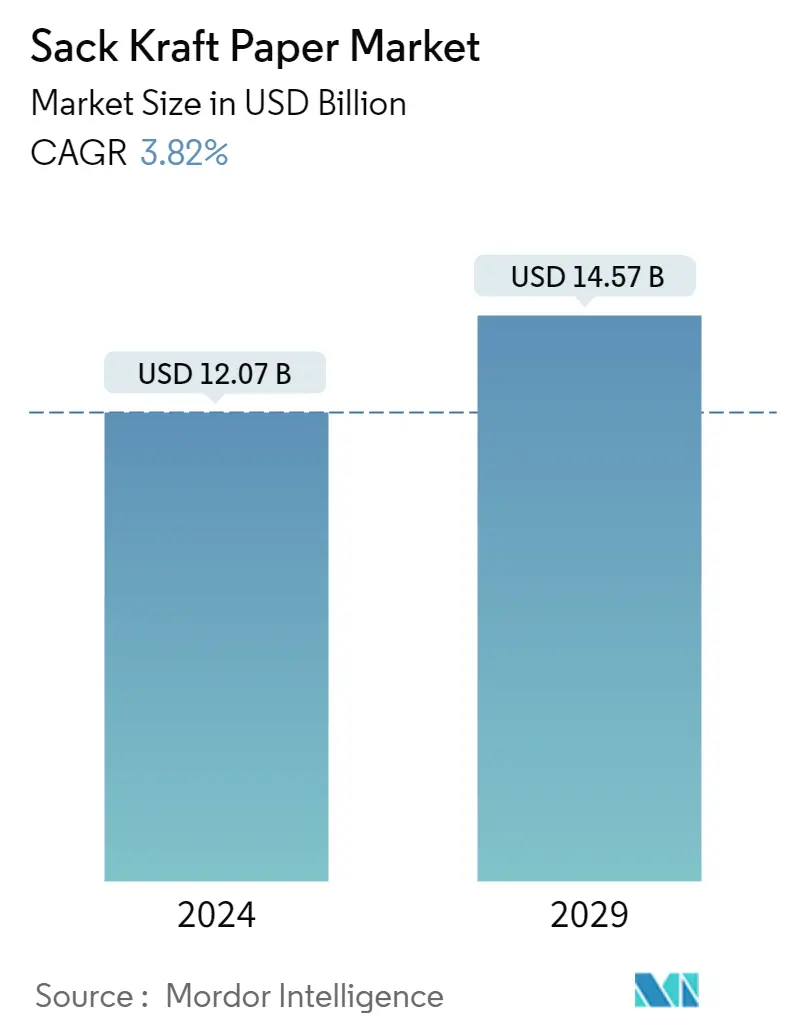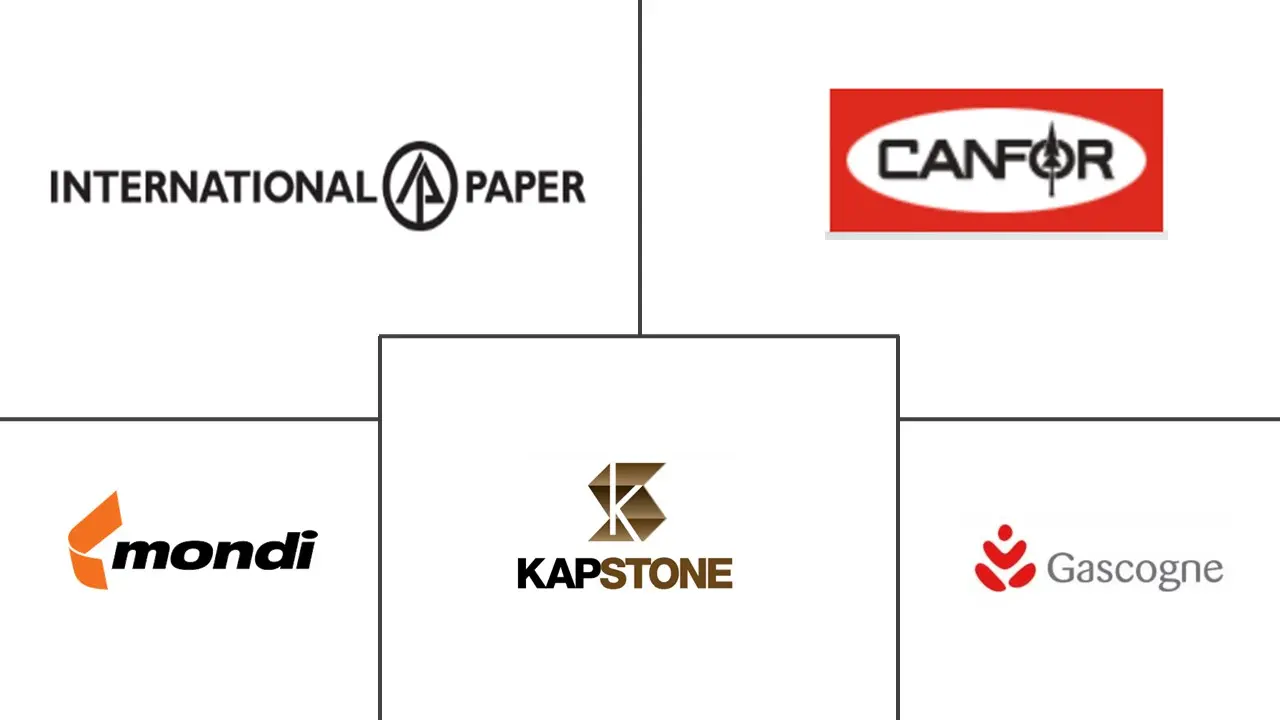Market Size of Sack Kraft Paper Industry

| Study Period | 2019 - 2029 |
| Market Size (2024) | USD 12.07 Billion |
| Market Size (2029) | USD 14.57 Billion |
| CAGR (2024 - 2029) | 3.82 % |
| Fastest Growing Market | Asia Pacific |
| Largest Market | Europe |
Major Players
*Disclaimer: Major Players sorted in no particular order |
Sack Kraft Paper Market Analysis
The Sack Kraft Paper Market size is estimated at USD 12.07 billion in 2024, and is expected to reach USD 14.57 billion by 2029, growing at a CAGR of 3.82% during the forecast period (2024-2029).
- The main factor driving the market's expansion is the building and construction industry's significant growth. Other major drivers of the sack kraft paper market growth are strict regulations and bans on plastic use in numerous regions of the packaging industry and improvements in packaging and wrapping applications.
- The growing awareness among environmentalists and governments about the hazards of using plastic is forcing them to focus on greener alternatives, favoring the adoption of sack kraft paper. Due to infrastructure projects, a steady rise in demand in the construction industry has increased the use of sack kraft paper. Also, increasing demand for eco-friendly and bio-degradable packaging material will promote growth. Additionally, according to the Bureau of International Recycling (BIR), around 420 million tonnes of paper and cardboard are produced yearly, with well over half of the raw material coming from recovered sources.
- Further, accepting the demand for biodegradable packaging as an alternative to plastic will increase market growth. For instance, in Canada, Plastic is polluting rivers, lakes, and oceans, harming wildlife, and generating microplastics in the water. Every year, Canadians throw away 3 million tons of plastic waste, only 9% of which is recycled, meaning the vast majority of plastic ends up in landfills, and about 29,000 tons find their way into the natural environment, according to Borden Ladner Gervais.
- Sacks filled with powdered materials, such as gypsum, cement, fine-grained sugar, clays, etc., which are necessary for high-quality papers, also exponentially aid market growth. The sack is also exposed to less strain during filling, leading to a lower sack breakage and increasing its adoption in the construction (cement) industry.
- The increasing popularity of e-commerce and related developments have led to the premiumization of kraft packaging. It includes the demand for kraft material that can take high-quality graphics on short print runs. Companies like Mondi have kept up with such developments and developed new products targeting premium creative print and packaging applications, including shopping bags. Moreover, players initiated many innovations that have improved and accelerated the production of sack kraft paper and paper sacks and enhanced product protection along with real-time calculations and selection of paper grade.
- However, the emergence of alternatives, such as plastic materials and flexible intermediate bulk containers and bulk bags, and the rise in the prices of sack kraft paper may hinder the market's growth.
- After the onset of COVID-19, global demand declined sharply in the wake of closures of non-essential businesses and lockdowns in many parts of North America, Europe, and Asia which pushed the companies to take a series of measures to mitigate the financial impacts. It includes extensive production curtailment, reduced capital spending, and disciplined cost management initiatives. However, by mid-year, a return to more normalized operation, lean inventories, and increased demand helped the major player operating in the market mitigate the impact of the pandemic. The overall packaging ecosystem across the globe has been impacted owing to the Russia-Ukraine war.
Sack Kraft Paper Industry Segmentation
The Sack Kraft Paper Market is tracked for the consumption of these papers for use in packaging for the market segmented by Packing Type (Valve Sacks, Open Mouth Sacks), Grade (Kraft, Semi-extensible, Extensible), End-user Vertical (Food, Chemical, Building Material, Cement), and Geography. The market is also analyzed through major importer-exporter countries to provide in-depth research using primary and secondary sources. The market sizes and forecasts are provided in terms of value (USD million) for all the above segments.
| By Packaging Type | |
| Valve Sacks | |
| Open Mouth Sacks | |
| Other Packaging Types |
| By Grade | |
| Kraft | |
| Semi-extensible | |
| Extensible | |
| Other Grades |
| By End-user Vertical | |
| Building Material and Cement | |
| Food | |
| Chemical | |
| Other End-user Verticals |
| Geography | ||||||||
| ||||||||
| ||||||||
| ||||||||
| ||||||||
| Middle East & Africa |
Sack Kraft Paper Market Size Summary
The sack kraft paper market is poised for steady growth, driven primarily by the burgeoning construction industry and the increasing demand for eco-friendly packaging solutions. The shift towards sustainable alternatives to plastic, spurred by stringent regulations and environmental concerns, is a significant factor propelling the market forward. The construction sector's reliance on sack kraft paper for packaging materials, such as those used for cement and other bulk goods, further bolsters demand. Additionally, the rise in e-commerce has led to a premiumization of kraft packaging, with companies innovating to meet the needs for high-quality, environmentally friendly packaging solutions. Despite challenges posed by alternative materials and fluctuating prices, the market is expected to expand as industries continue to seek sustainable packaging options.
Regionally, the UK and Europe are key players in the sack kraft paper market, with significant production capabilities and a strong focus on meeting the demands of the food sector. The presence of major global companies and ongoing investments in production capacity and technology enhancements underscore the market's growth potential. The UK's strategic position, with its numerous mills and export capabilities, along with Europe's commitment to sustainable packaging solutions, positions the region as a leader in the market. The market's fragmented nature, characterized by numerous players and vertical integration trends, suggests a competitive landscape where innovation and strategic investments will be crucial for maintaining market share and meeting evolving consumer preferences.
Sack Kraft Paper Market Size - Table of Contents
-
1. MARKET INSIGHTS
-
1.1 Market Overview
-
1.2 Industry Value Chain Analysis
-
1.3 Industry Attractiveness - Porter's Five Force Analysis
-
1.3.1 Bargaining Power of Suppliers
-
1.3.2 Bargaining Power of Buyers/Consumers
-
1.3.3 Threat of New Entrants
-
1.3.4 Threat of Substitute Products
-
1.3.5 Intensity of Competitive Rivalry
-
-
1.4 Impact of COVID-19 on the Market
-
-
2. MARKET SEGMENTATION
-
2.1 By Packaging Type
-
2.1.1 Valve Sacks
-
2.1.2 Open Mouth Sacks
-
2.1.3 Other Packaging Types
-
-
2.2 By Grade
-
2.2.1 Kraft
-
2.2.2 Semi-extensible
-
2.2.3 Extensible
-
2.2.4 Other Grades
-
-
2.3 By End-user Vertical
-
2.3.1 Building Material and Cement
-
2.3.2 Food
-
2.3.3 Chemical
-
2.3.4 Other End-user Verticals
-
-
2.4 Geography
-
2.4.1 North America
-
2.4.1.1 United States
-
2.4.1.2 Canada
-
-
2.4.2 Europe
-
2.4.2.1 United Kingdom
-
2.4.2.2 France
-
2.4.2.3 Germany
-
2.4.2.4 Italy
-
2.4.2.5 Spain
-
2.4.2.6 Rest of Europe
-
-
2.4.3 Asia-Pacific
-
2.4.3.1 China
-
2.4.3.2 Japan
-
2.4.3.3 India
-
2.4.3.4 Rest of Asia-Pacific
-
-
2.4.4 Latin America
-
2.4.4.1 Brazil
-
2.4.4.2 Mexico
-
-
2.4.5 Middle East & Africa
-
-
Sack Kraft Paper Market Size FAQs
How big is the Sack Kraft Paper Market?
The Sack Kraft Paper Market size is expected to reach USD 12.07 billion in 2024 and grow at a CAGR of 3.82% to reach USD 14.57 billion by 2029.
What is the current Sack Kraft Paper Market size?
In 2024, the Sack Kraft Paper Market size is expected to reach USD 12.07 billion.

